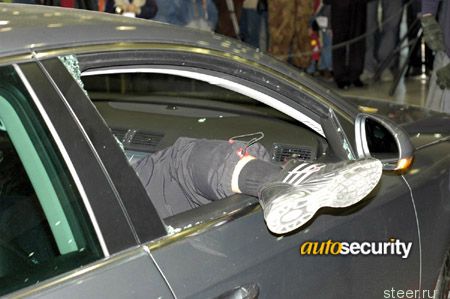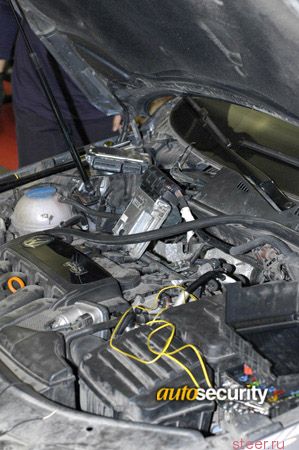How steal your cars Theft technology in pictures
1) The classic method of robbery is shown in the film "How to steal a million". A person outside the protected area threw a boomerang that crossed the infrared rays used for protection. The alarm system produced alarm signals, which the guards considered false. After a series of such "false" alarms, the alarm was turned off, which enabled the person to penetrate unnoticed into the guarded premises. Often the same principle is used for car theft. Causes the alarm to fire until the owner disconnects it. After this, in the absence of reliable lockers to steal a car is not difficult.
2) Hijacker's companions try to neutralize the owner of the car. At night, they can detain him by blocking the door of the porch in which he lives. If the owner is in the store, the partners can inform the hijacker of the actions of the owner and, if necessary, detain him at the exit from the store, which will enable the hijacker to hide.
3) Hijackers monitor the car owner and use his oversights. Typical missteps leading to car theft:
- forgot to turn on the alarm;
- forgot to turn on the pager (if available) or not changed the battery in time;
- For a long time he departed from the car beyond the audible signals of the siren and pager;
- forgot the keys in the ignition lock (strangely enough, this sometimes happens if the doors are closed remotely with a keychain, and the key chain is worn separately from the keys).
4) As a last resort in relation to the owner the hijacker can use force. There is a case where the owner, trying to prevent the theft of his car, received a blow from the hijacker by the eye. As a result, the year of treatment and disability.
5) At a meeting with the police, the hijacker tries:
- imitating an alcoholic: "... got into the car to drink a bottle of beer ...";
- to deny the fact of stealing, referring, for example, to "weighty" reasons: "... it was necessary urgently to bring the medicine to the sick person." And, of course, I would put the car in place ... ";
- buy off;
To run away.
6) The cold-blooded actions of the hijackers, similar to those of the car owner, do not attract the attention of outsiders. However, the hijacker prefers to act away from informed witnesses - neighbors, relatives.
7) On the kidnapped car, the necessary documents can be prepared in advance: a power of attorney, a technical passport, a ticket for those. Inspection.
8) Hijackers usually operate in groups with a clear distribution of functions. In the case of an unsuccessful attempt to steal and to ensure the possibility of quickly disappearing, close to the place of hijacking leave their car with a starved engine and driver.
9) Experienced hijackers determine the type of security system and suggest a way to overcome it. The direct executors of the theft are often teenagers. According to the current legislation, adolescents are less responsible for the crime committed than adults.
10) When "working" directly with the car, the hijackers try first of all to disable the siren or at least to drown it for a while, for example, by the sound of a nearby car with a damaged silencer, the pager's signal is jammed with a powerful source of radio interference. Usually a siren and a pager are disabled for a few seconds. The type of pager and its presence is determined by observing the owner of the car or by gluing an antenna on the windshield.
11) Penetration into the car. How does a hijacker get into a car? Unfortunately, it is extremely simple. The doors and hood are easily opened with skeleton keys, of which there is a great variety. In this case, as a rule, the larvae of the locks are not affected. The simplest way to get into the salon is to take out the rear window, cutting off the rubber band or just breaking the side window and opening the door.
12) Actions after penetration into the car interior.
The anti-theft latch on the steering column is broken by hands. To break out the larvae of the ignition lock, a tool made of high-strength steel resembling a large screwdriver with a lever can be used. For domestic cars this, in fact, is not required. The hijacker can disconnect the connector from the ignition and, connecting the necessary wires or inserting a lock in the connector, try to start the engine. Few people know that locks on the pedals are not a serious anti-theft device, since the hijacker can leave without pressing either gas, clutch, or brake (!), However, not very quickly; Or remove the lock by biting the foot pedals. Descriptions of specific actions of hijackers to overcome certain mechanical blockers are often published in periodicals and are an incentive for developers of anti-theft devices to improve their characteristics, leading to the creation of fundamentally new lockers (see Section 7.3).
13) For most common brands of cars, a professional hijacker stores a so-called "spider". "Spider" is a bundle of wires, on the one hand ending with the ignition switch with the switch (in the case of electronic ignition), on the other - crocodiles and special mortise clamps for "instant" connection. After opening the hood, the regular wiring, which ensures the movement of the car, is completely cut and a new one is installed. Harness "spider" is laid directly outside the car from under the hood into the cabin. The process takes 0.5 - 2.0 minutes (!). It is obvious that in this way virtually any electronic anti-theft system is neutralized on cars that do not have complicated computer control of engine operation.
14) Instead of "spider" the hijacker can use a high-frequency pulse generator, which "makes" the candles all the time spark. In this case, the car is going badly, but still going.
15) In order to eliminate the effect of the anti-theft gasoline valve, which can be installed on the car, the hijacker cuts the petrol line near the carburetor and connects its small capacity with gasoline.
16) Not all hijackers are so professional to prepare and use a "spider" or HF generator. But all the hijackers know that if you disconnect all the connectors from the alarm control unit, then this ends its work. This is true for most spaced alarms (that is, alarms, in which the control unit is separated from the siren). If you disconnect the connector from the monoblock alarm (which all consists of one unit), the car does not start, but in this case, connect certain wires in a bundle, suitable for the monoblock, thus eliminating the engine blockage. The locking of systems with "armored" blocks, from which single-colored wires leave, is somewhat more complicated. Here it is also necessary to unscrew several screws - in order to open the unit - it becomes further clear which wires to connect (of course, if this issue has been previously worked out). Finding the location of the unit does not take much time - such places in domestic cars - two or three maximum. The search time is one or two minutes. Monoblock is usually not necessary to search - it is installed under the hood in a conspicuous place.
17) A hijacker may have a scanner or grabber - electronic devices that pick up an alarm code or record it at a time when the car owner uses a key fob to turn off the alarm. That is, if the alarm is susceptible to scanning or grabbing, the hijacker becomes the owner of the electronic master key to turn it off. The modern scanner ("police key") and grabber (more precisely, the radio signal recorder) are not larger than a pack of cigarettes and quite an acceptable price: 200 and 5000 dollars respectively.
18) The actions of hijackers are unconventional and unpredictable not only for the car owner, but also for the experienced alarm installer.
20) Hijacking with the help of a fishing line and sticks, shown in one of the telecasts. To the car's axis is attached a fishing line 10 meters long, at the end there is a rod. The owner starts the car in the morning, passes a few meters, until the line is wound around the axis, and suddenly - hears a knock. It turns out, without muffling the engine, and climbs under the car. The hijacker jumps into the car and leaves.
21) The hijacker can collude with the alarm installer, and after a while after installation quickly and quietly steal the car. The simplest option is when the installer sends the hijacker a cast of keys and a third key fob (if the alarm can "remember" more than 2 trinkets).
22) A hijacker can steal keys and a keychain from the owner and calmly leave.
23) The hijacker can make the keys to the ignition lock, using the larva of the lock removed from the hatch of the gas tank the previous day (many cars have a single key for all locks).
24) After the hijacking, the car is either quickly disassembled or settled. This checks for the presence of radio transmitting devices, the power is turned off.
25) In case of an unsuccessful attempt to steal, an experienced thief leaves the car without leaving traces, so as not to cause suspicion of the owner. The case of the termination of the attempted hijacking of the VAZ-2109 is known after the discovery of the fort installed on it; The lock was not removed; The owner of the attempted theft did not recognize.












Comments
When commenting on, remember that the content and tone of your message can hurt the feelings of real people, show respect and tolerance to your interlocutors even if you do not share their opinion, your behavior in the conditions of freedom of expression and anonymity provided by the Internet, changes Not only virtual, but also the real world. All comments are hidden from the index, spam is controlled.